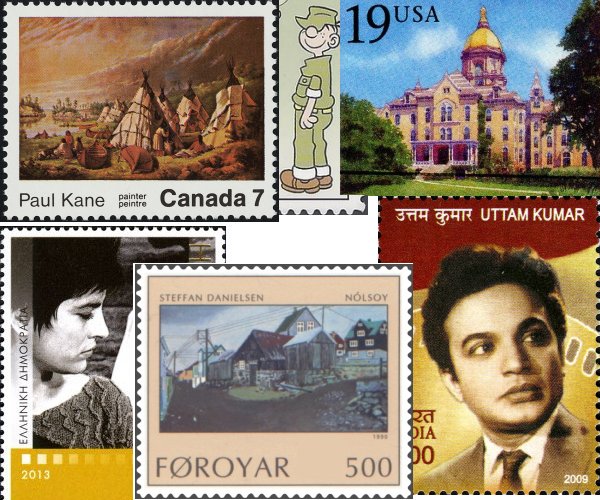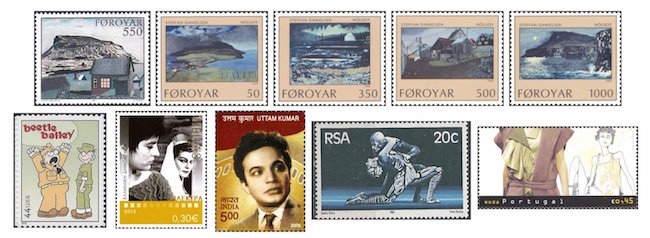The Arts on Stamps of the World — September 3
An Arts Fuse regular feature: the arts on stamps of the world.

By Doug Briscoe
Today’s salute to artists appearing on postage stamps of the world begins with Canadian painter Paul Kane (September 3, 1810 – February 20, 1871), known for his pictures of Native Americans. Kane had been born in Ireland to an Englishman in the Royal Horse Artillery. During Kane’s childhood the family relocated to Canada, ending up in Toronto (then known as York). When Kane was 26 he moved to Detroit and began traveling the American Midwest, making his living painting portraits until, in 1841, he was able to afford passage to Europe. He did not have formal training there, but did assiduously study the masters in museum settings in France, Italy, and London. Back in the U.S., Kane resumed painting portraits at his studio in Mobile, Alabama so as to pay off his debts for the European excursion. At last he returned home to York and began the voyages through the Canadian northwest that would result in his best known work. Kane would sketch in situ and paint oils back at York, often taking considerable liberties with details. Exhibitions of these pieces, both sketches and paintings, met with great success. He also produced a book with the mouthful title of The Wanderings of an Artist among the Indians of North America from Canada to Vancouver’s Island and Oregon through the Hudson’s Bay Company’s Territory and Back Again (1859). Toward the end of his life his eyesight failed to the extent that he had to give up painting. The Canadian stamp of 1971 shows his Indian Encampment on Lake Huron.
September 3rd is the birthday of 19th-century Costa Rican composer Manuel María Gutiérrez (though another source cites the 1st). Spanish- and Russian-language Wikipedia (there is no English-language equivalent) give out that he lived from 3 September 1829 to 25 December 1887. The website Guías Costa Rica, however— which includes a nice bio of the composer, says his birthday was 1 September. He played in the military band of his native town of Heredia from the age of 13 and was made director of the band in 1846, while still in his teens. Subsequently he was made general director of bands in all of Costa Rica, and it was in that year, 1853, that he wrote the national anthem of the country (new words were added in 1900). He wrote some forty works for band. A colorful anecdote exists about his march “Santa Rosa.” During the Filibuster War of the mid-1850s, Gutiérrez, an officer in the Costa Rican army, was working on composing the march when he heard the approach of enemy cavalry. He hid in a tree, and when the riders had passed, descended and completed writing his march.
American architect Willoughby J. Edbrooke (3 September 1843 – 25 March 1896) was supervising architect for the U.S. Treasury Department in the years 1891-92 and in that short time initiated the design of at least forty buildings. He worked out of Chicago and made buildings for Notre Dame University, including the administration building with its golden dome, as seen on the later (1991) of two postal cards commemorating his Edbrooke’s work. The earlier one, from 1983, shows the Old Post Office Building in Washington, D.C. (1892–99), though on this project Edbrooke’s design was modified by no fewer than five other architects. Another of Edbrook’es creations was the Wheeler Opera House in Aspen, Colorado (1888–89).

The Czech illustrator František Bidlo (3 September 1895 – 9 May 1945) was born in poverty and died in the Holocaust. Unable to complete even his high school education, he learned by frequenting the art cafes of Prague and created posters and cartoons and some book illustrations. As a firm Communist, he fell afoul of the German authorities during the Nazi occupation and was sent to Terezín, where, weakened by typhus and diphtheria, he succumbed. Czechoslovakia issued a stamp showing two of his illustrations, “The Conference on Disarmament in Geneva” (1927) and “The Prophecy of Three Parrots” (1933), two examples of his pre-war anti-fascist posters.
Another self-taught artist was the Faroese painter Steffan Danielsen (3 September 1922 –28 May 1976). He was born in the village of Nólsoy on the island of the same name (the only village on the island) and was inspired by local scenery, which has been featured on two Faroese stamp issues, the first, from 1959, offering Winter’s Day in Nólsoy, and the second, forty years later, providing a set of four more stamps reproducing his canvases.
Addison Morton “Mort” Walker (born September 3, 1923) is the creator of two long-lived comic strips, Beetle Bailey from 1950 and Hi and Lois from 1954. Kansas-born and Kansas City (Missouri) bred, Walker was a published cartoonist at 11 and a paid one at 12. By 14, he was regularly selling gag cartoons to magazines and started up his own first strip for the weekly Kansas City Journal when he was only 15. At 18, he was named chief editorial designer for Hallmark greeting cards. During the war he was an intelligence officer in Italy and was in charge of a German POW camp. In 1974, Walker founded the first museum devoted to the art of comics, the Museum of Cartoon Art. It started in Greenwich, Connecticut, moved to Rye Brook, New York, and is now (since 1992) situated in Boca Raton, Florida. Walker has been productive in more ways than one. Six of his nine children are employed at his Connecticut studio, two of them working on the ongoing Hi and Lois strip. Beetle Bailey was one of the comic strips chosen for a sheet of stamps that came out in 2010.

Our next two figures are both actors, neither of them an American but one quite well known here, the other less so, though hugely popular in his native country. Both were born on precisely the same day, 3 September 1926. Irene Papas (Pappas) was born Irini Lelekou near Corinth, Greece to parents who were teachers. She studied dance and singing in Athens and was discovered by Elia Kazan. After much work in Greek and Italian films, she was chosen to play in J. Lee Thompson’s terrific war drama The Guns of Navarone (1961) opposite Gregory Peck, David Niven, and Anthony Quinn. In the same year she took the title role in a film version of Sophocles’ Antigone, following that up in 1962 with a portrayal of Euripides’ Elektra. The stamp shows her in that role (at left) with Aleka Katselli as Klytaemnistra. Papas is perhaps best known in the U.S. for her part in Zorba the Greek (1964). During filming she got to know composer Mikis Theodorakis and five years later put out an album of his songs. In that year, 1969, she also played Catherine of Aragon in Anne of the Thousand Days with Richard Burton and Geneviève Bujold. A happy 89th birthday to Irene Papas!
The other actor is the Bengali Indian superstar Uttam Kumar (3 September 1926 – 24 July 1980), born Arun Kumar Chatterjee. He came from Kolkata and from a large family that had its own theater troupe. After a slow start in the movies and several name changes, Kumar has his first success in 1954, when a professional partnership was formed with the actress Suchitra Sen. He also worked with his younger brother Tarun Kumar in a number of films. Hugely popular in India, cited by some as the greatest actor and most popular star of Bengali cinema, Kumar went on to diversify as director, producer, singer, and composer. His finest role may have been in Satyajit Ray’s 1966 film Nayak (The Hero). It has been suggested that Ray wrote the part expressly for him. Kumar also worked in fifteen Hindi films.
Serial composer Graham Newcater, who turns 76 today, studied with Peter Racine Fricker, Adrian Boult (conducting), and Humphrey Searle. Newcater has written at least three symphonies (the last in 1978) and four concertos, besides numerous other orchestral, chamber, and vocal works, but his greatest success to date was with the first of his three ballets, Raka (1967), which was made into a film in 1968 and which features on a 1981 stamp issued to commemorate the opening of the South African State Theatre in Pretoria.
Finally today, we say hello and happy birthday to award-winning Portuguese fashion designer Luís Buchinho (born 3 September 1969), one of several couturiers saluted on a recent sets of stamps from that country.
A nod, too, to Maine fiction writer and poet Sarah Orne Jewett (September 3, 1849 – June 24, 1909).
A graduate of the University of Massachusetts with a B.A. in English, Doug Briscoe worked in Boston classical music radio, at WCRB, WGBH, and WBUR, for about 25 years, beginning in 1977. He has the curious distinction of having succeeded Robert J. Lurtsema twice, first as host of WGBH’s weekday morning classical music program in 1993, then as host of the weekend program when Robert J.’s health failed in 2000. Doug also wrote liner notes for several of the late Gunther Schuller’s GM Recordings releases as well as program notes for the Boston Classical Orchestra. For the past few years he’s been posting a Facebook “blog” of classical music on stamps of the world, which has now been expanded to encompass all the arts for The Arts Fuse.
